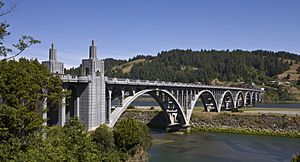Isaac Lee Patterson Bridge facts for kids
Quick facts for kids Isaac Lee Patterson Bridge |
|
|---|---|
 |
|
| Coordinates | 42°25′38″N 124°24′48″W / 42.4272°N 124.4133°W |
| Carries | 2 lanes of |
| Crosses | Rogue River |
| Locale | Gold Beach, Oregon to Wedderburn, Oregon |
| Maintained by | State of Oregon |
| ID number | 01172 009 32764 |
| Characteristics | |
| Design | Concrete arch-deck |
| Total length | 591 m (1938ft) |
| Width | 8.2 m (26.9ft) |
| Longest span | 70 m (230 ft), 7 spans |
| History | |
| Opened | May 28, 1932 |
| Statistics | |
| Daily traffic | 6200 |
|
Rogue River Bridge No. 01172
|
|
| Lua error in Module:Location_map at line 420: attempt to index field 'wikibase' (a nil value). | |
| Location | OR Coast 9, US 101, MP 327.70, Gold Beach, Oregon |
|---|---|
| Area | 2.6 acres (1.1 ha) |
| Built | 1932 |
| Architect | Conde B. McCullough; Mercer-Fraser Co. |
| MPS | McCullough, C.B., Major Oregon Coast Highway Bridges MPS |
| NRHP reference No. | 05000814 |
| Added to NRHP | August 5, 2005 |
The Isaac Lee Patterson Bridge is a famous concrete bridge in Oregon. It is also known as the Rogue River Bridge. This bridge crosses the Rogue River in Curry County, Oregon. The river flows into the Pacific Ocean nearby.
The bridge connects the towns of Gold Beach and Wedderburn. It carries U.S. Route 101, a major highway. The Mercer Fraser Company built this bridge.
The Isaac Lee Patterson Bridge is a great example of Art Deco style. This was a popular design style in the 1920s and 1930s. The bridge was designed by Conde McCullough. He was a very important bridge designer and highway engineer in Oregon.
This bridge is one of many special bridges McCullough designed. They are all along the Oregon Coast Highway. In 1982, it was named a National Historic Civil Engineering Landmark. This means it's a very important engineering achievement. The bridge was also added to the National Register of Historic Places in 2005.
Building the Bridge
Building the Isaac Lee Patterson Bridge was a big project. The state of Oregon gave the building contract to the Mercer, Fraser Company. This happened on January 16, 1930. Work on the bridge started in April 1930.
The bridge was built using a special method. This method helped prevent the concrete from shrinking. It used powerful hydraulic jacks to stretch the arches. This was the first time this technique was used in the United States.
The building site was far away from cities. This made it a challenge. Steel for the bridge came from Port Orford. A concrete plant was built right on the river's north bank. The wood for the bridge's supports came from nearby.
The bridge was supposed to open in January 1932. But a flood damaged the local ferry in December 1931. So, the bridge opened early on December 24, 1931. It was officially dedicated on May 28, 1932. The bridge was named after Isaac Lee Patterson. He was the governor of Oregon from 1927 to 1929.
Bridge Design and Features
The Isaac Lee Patterson Bridge is very long. It measures about 1,938 feet (591 meters). It has seven main arch sections. Each of these sections is about 230 feet (70 meters) long. The road on the bridge is about 27 feet (8.2 meters) wide. The entire structure is about 34 feet (10.4 meters) wide.
The ends of the bridge have strong supports called piers. Some piers rest on solid rock. Others rest on long wooden poles driven into the ground. These poles are called timber pilings. Some piers have poles driven at an angle. This helps them stand strong against sideways pushes.
The bridge has many cool design details. It shows the Art Deco style. There are tall, decorative towers at each end. These towers have stepped shapes. They also have special windows with sunburst designs above them. The railings along the bridge are simple and straight. They have small arches on short columns.
Because the bridge is near the ocean, salt air can cause problems. So, it needs a lot of care. From 2001 to 2004, a big repair project happened. It cost $20 million to keep the bridge in good shape. Earlier, in 1976, work was done to fix problems with water washing away soil around one of the piers.
Building the bridge used a lot of materials. Workers dug up over 10,000 cubic yards of earth. They used over 15,000 cubic yards of concrete. They also used more than 1.7 million pounds of steel for strength.
Historic Recognition
The Isaac Lee Patterson Bridge was added to the National Register of Historic Places on August 5, 2005. This means it is recognized as an important historic place.


